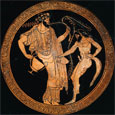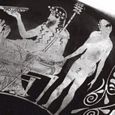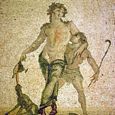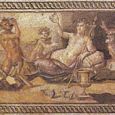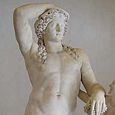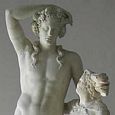KOMOS
Greek Name
Κωμος
Transliteration
Kômos
Latin Spelling
Comus
Translation
Revelry, Festivity

KOMOS (Comus) was the god of revelry, merrymaking and festivity. He was the son and cup-bearer of the god Dionysos. Komos was depicted as either a winged youth or a satyriskos (child-satyr) with balding pate and asses' ears.
FAMILY OF COMUS
PARENTS
DIONYSOS (Other references)
ENCYCLOPEDIA
COMUS (Kômos), occurs in the later times of antiquity as the god of festive mirth and joy. He was represented as a winged youth, and Philostratus (Icon. i. 2) describes him as he appeared in a painting, drunk and languid after a repast, his head sunk on his breast; he was slumbering in a standing attitude, and his legs were crossed.
Source: Dictionary of Greek and Roman Biography and Mythology.
CLASSICAL LITERATURE QUOTES
Philostratus the Elder, Imagines 1. 2 (trans. Fairbanks) (Greek rhetorician C3rd
A.D.) :
"[Ostensibly a description of an ancient Greek painting at Neapolis (Naples) :] The spirit Komos (Comus,
Revelry), to whom men owe their revelling, is stationed at the doors of a chamber--golden doors, I think they
are; but to make them out is a slow matter, for the time is supposed to be at night. Yet night is not
represented as a person, but rather it is suggested by what is going on; and the splendid entrance indicates a
very wealthy pair just married who are lying on a couch. And Komos has come, a youth to join the youths,
delicate and yet full grown, flushed with wine and, though erect, he is asleep under the influence of drink. As
he sleeps the face falls forward on the breast so that the throat is not visible, and he holds his left hand up
to his ear. The hand itself, which has apparently grasped the ear,
is relaxed and limp, as is usual at the beginning of slumber, when sleep gently invites us and the mind passes
over into forgetfulness of its thoughts; and for the same reason the torch seems to be falling from his right
hand as sleep relaxes it. And for fear lest the flames of the torch come too near his leg, Komos bends his lower
left leg over towards the right and holds the torch out on his left side, keeping his right hand at a distance
by means of the projecting knee in order that he may avoid the breath of the torch.
While painters ought usually to represent the faces of those who are in the bloom of youth, and without these
the paintings are dull and meaningless, this Komos has little need of a face at all, since his head is bent
forward and the face is in shadow. The moral, I think, is that persons of his age should not go revelling,
except with heads veiled. The rest of the body is sharply defined, for the torch shines on every part of it and
brings it into the light. The crown of roses should be praised, not much for its truth of representation--since
it is no difficult achievement, for instance with yellow and dark blue pigments, to imitate the semblance of
flowers--but one must praise the tender and delicate quality of the crown. I praise, too, the dewy look of the
roses, and assert that they are painted fragrance and all.
And what else is there of the revel? Well, what but the revellers? Do you not hear the castanets and the flute's
shrill note and the disorderly singing? The torches give a faint light, enough for the revellers to see what is
close in front of them, but not enough for us to see them. Peals of laughter rise, and women rush along with
men, wearing men's sandals and garments girt in strange fashion; for the revel permits women to masquerade as
men, and men to put on women's garb and to ape the walk of women. Their crowns are no longer fresh but, crushed
down on the head on account of the wild running of the dancers, they have lost their joyous look; for the free
spirit of the flowers deprecates the touch of the hand as causing them to wither before their time. The painting
also represents in a way the din which the revel most requires; the right hand with bent fingers strikes the
hollowed palm of the left hand, in order that the hands beaten like cymbals may resound in unison."
Philostratus the Elder, Imagines 1. 25 :
"Dionysos sails to the revels of [the island of] Andros and, his ship now moored in the harbour, he leads a
mixed throng of Satyroi (Satyrs) and Bakkhantes (Bacchantes) and all the Seilenoi (Silens). He leads Gelos
(Laughter) and Komos (Comus, Revelry), two spirits most gay and most fond of the drinking-bout, that with the
greatest delight he may reap the river's harvest."
Nonnus, Dionysiaca 2. 699 ff (trans. Rouse) (Greek epic C5th A.D.) :
"Athena came into heaven unarmed, in dainty robes with Ares turned Komos (Comus), and Nike (Victory) for
Melos (Song)."
N.B. Milton in his Comus calls the god a son of Bacchus and Circe. However this is a post-classical invention.
ANCIENT GREEK & ROMAN ART
SOURCES
GREEK
- Philostratus the Elder, Imagines - Greek Rhetoric C3rd A.D.
- Nonnus, Dionysiaca - Greek Epic C5th A.D.
BIBLIOGRAPHY
A complete bibliography of the translations quoted on this page.
